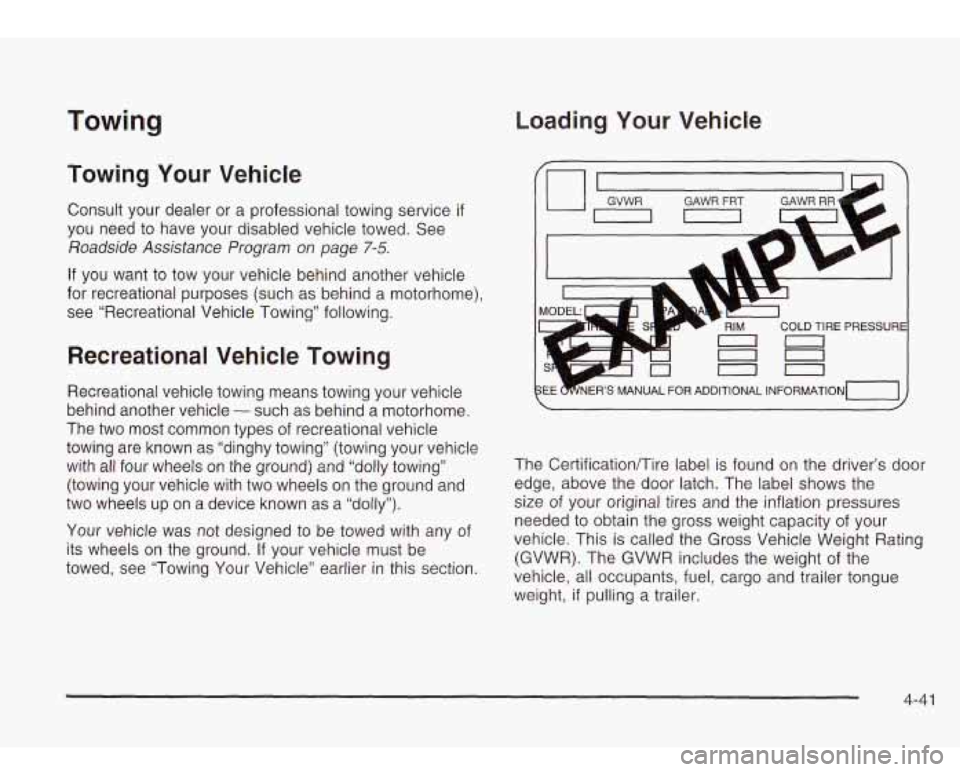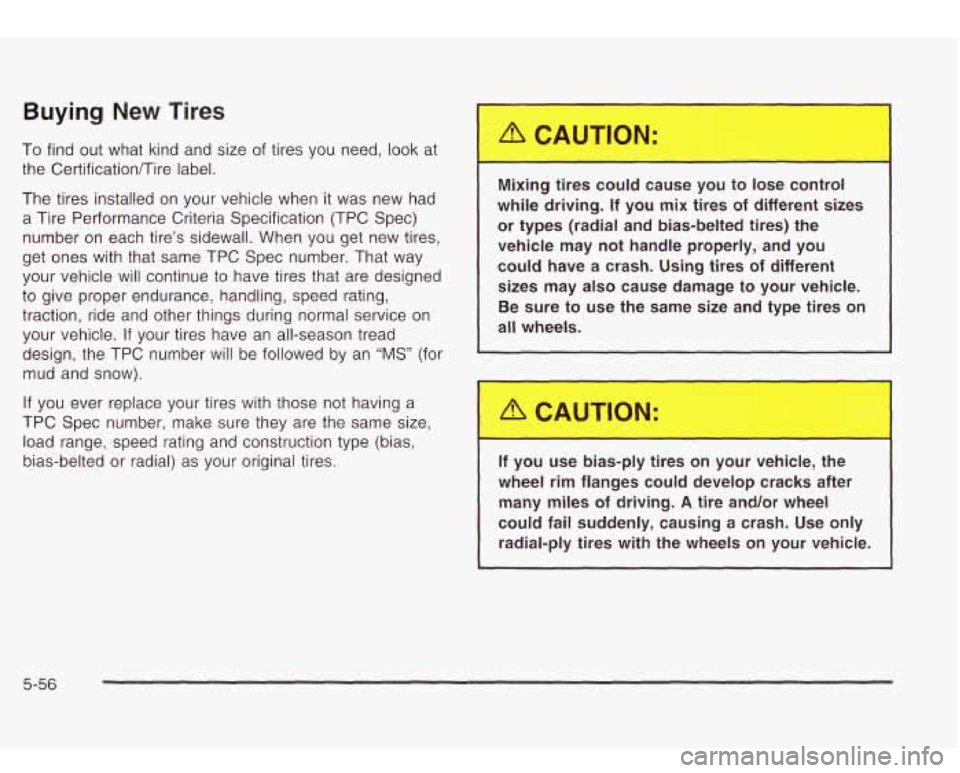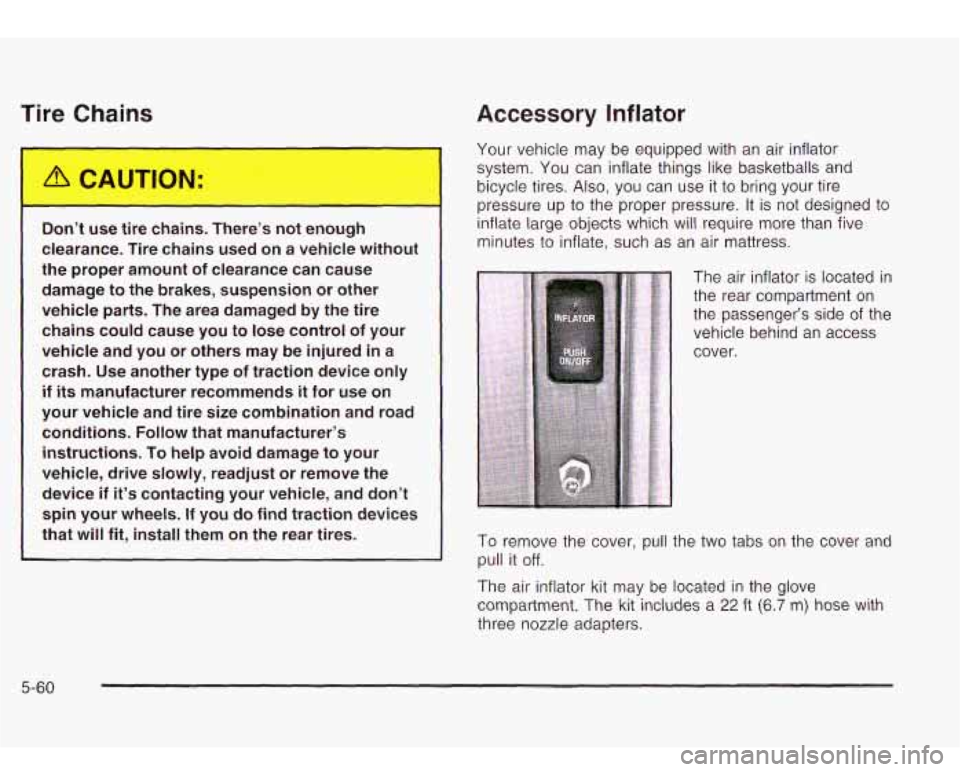tire size Oldsmobile Bravada 2003 Owner's Manuals
[x] Cancel search | Manufacturer: OLDSMOBILE, Model Year: 2003, Model line: Bravada, Model: Oldsmobile Bravada 2003Pages: 410, PDF Size: 20.1 MB
Page 246 of 410

Towing Loading Your Vehicle
Towing
Your Vehicle
Consult your dealer or a professional towing service if
you need to have your disabled vehicle towed. See
Roadside Assistance Program on page 7-5.
If you want to tow your vehicle behind another vehicle
for recreational purposes (such as behind a motorhome),
see “Recreational Vehicle Towing” following.
Recreational Vehicle Towing
Recreational vehicle towing means towing your vehicle
behind another vehicle
- such as behind a motorhome.
The two most common types of recreational vehicle
towing are known as “dinghy towing” (towing your vehicle
with all four wheels on the ground) and “dolly towing”
(towing your vehicle with two wheels on the ground and
two wheels up on a device known as a “dolly”).
Your vehicle was not designed to be towed with any
OJ
its wheels on the ground. If your vehicle must be
towed, see “Towing Your Vehicle” earlier in this section. The
Certificationflire label is found on the driver’s door
edge, above the door latch. The label shows the
size of your original tires and the inflation pressures
needed to obtain the gross weight capacity of your
vehicle. This is called the Gross Vehicle Weight Rating (GVWR). The GVWR includes the weight of the
vehicle, all occupants, fuel, cargo and trailer tongue
weight,
if pulling a trailer.
Page 314 of 410

When It Is Time for New Tires
One way to tell when it’s
time for new tires is to
check the treadwear indicators, which will
appear when your tires have only
1/16 inch
(1.6 mm) or less of tread
remaining. Some
commercial truck tires may
not have treadwear
indicators. You
need a new tire
if any of the following statements
are true:
You can see the indicators at three or more places
0 You can see cord or fabric showing through the
tire’s rubber.
The tread or sidewall
is cracked, cut or snagged
deep enough to show cord or fabric.
around the tire.
The tire has a
bump, bulge or split.
0 The tire has a puncture, cut or other damage that
can’t be repaired well because of the size or
location of the damage.
5-55
Page 315 of 410

Buying New Tires
To find out what kind and size of tires you need, look at
the Certificationnire label.
The tires installed on your vehicle when it was new had
a Tire Performance Criteria Specification (TPC Spec)
number on each tire’s sidewall. When you get new tires,
get ones with that same TPC Spec number. That way
your vehicle will continue
to have tires that are designed
to give proper endurance, handling, speed rating,
traction, ride and other things during normal service on
your vehicle. If your tires have an all-season tread
design, the TPC number will be followed by an
“MS” (for
mud and snow).
If you ever replace your tires with those not having a
TPC Spec number, make sure they are the same size,
load range, speed rating and construction type (bias,
bias-belted or radial) as your original tires. Mixi-.,
--:es could cause
, - . o lose control
while driving. If you mix tires
of different sizes
or types (radial and bias-belted tires) the
vehicle may not handle properly, and you
could have a crash. Using tires
of different
sizes may also cause damage to your vehicle. Be sure to use the same size and type tires on
all wheels.
If you
--e bias-pi, ;ires c.. yo^. Jehicle, the
wheel rim flanges could develop cracks after many miles of driving.
A tire and/or wheel
could fail suddenly, causing a crash. Use only
radial-ply tires with the wheels on your vehicle.
5-56
Page 319 of 410

lire Chains
Accessory Inflator
I^
Do.. - use tire ch-..ls. There’s no- _.__ugh
clearance. Tire chains used on a vehicle without
the proper amount of clearance can cause
damage to the brakes, suspension or other
vehicle parts. The area damaged by the tire
chains could cause you to lose control of your
vehicle and you or others may be injured
in a
crash. Use another type of traction device only if
its manufacturer recommends it for use on
your vehicle and tire size combination and road
conditions. Follow that manufacturer’s instructions.
To help avoid damage to your
vehicle, drive slowly, readjust or remove the device
if it’s contacting your vehicle, and don’t
spin your wheels.
If you do find traction devices
that will fit, install them on the rear tires. Your
vehicle may be equipped with an air inflator
system. You can inflate things like basketballs and
bicycle tires.
Also, you can use it to bring your tire
pressure up to the proper pressure. It is not designed to
inflate large objects which will require more than five
minutes to inflate, such as an air mattress.
To remove the cover, pull the two tabs on the cover and
pull
it off.
The air inflator kit may be located in the glove
compartment. The kit includes a
22 ft (6.7 m) hose with
three nozzle adapters.
5-60